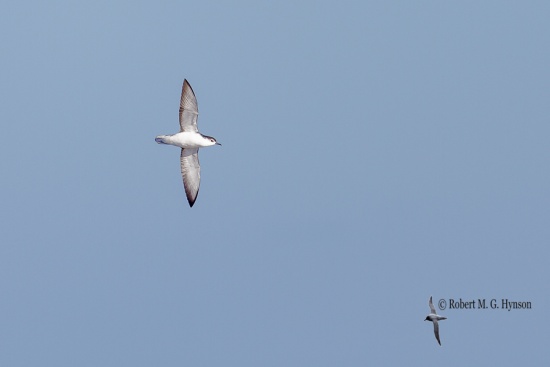- Puffinus assimilis
Includes: Subantarctic Shearwater
Identification
25-30cm
- Very dark upperparts
- Pale area on upperside of secondaries, more so on worn birds
- White underparts
- Underwing very white with thinner black trailing edge than similar species
- Wings shorter and rounder than similar species; does not reach tip of tail on resting bird
- Body relatively longer than similar species
- White cheeks extend up to sides of crown encircling dark eye (this is true for forms from Australia, but for example not for elegans that have black sides of head)
- Rounded head
- Dark peak reaching slightly down into the white underside behind head
- Slim bill shorter than similar species
- Legs and feet pale blue
- In flight on a calm day may remind of a smaller Alcid.
Similar Species
Manx Shearwater, Audubon's Shearwater, Macaronesian Shearwater, and Townsend's Shearwater.
Distribution
Oceanic wanderers with breeding centres in the Southern Oceans and the Southern Atlantic
Taxonomy
Clements[1], Gill and Donsker[2] and Dickinson[3] don't completely agree on the taxonomic treatment of this species.
The first two have split Macaronesian Shearwater from this species (later split into Barolo Shearwater and Boyd's Shearwater). Dickinson however has followed Austin and others and has transferred baroli and boydi to Audubon's Shearwater. myrtae was also formerly included as subspecies in Little Shearwater but then transferred to Newell's Shearwater and later accepted as full species Rapa Shearwater. Gill and Donsker further split elegans as Subantarctic Shearwater.
Subspecies
5 subspecies recongized:[1]
- P. a. tunneyi:
- Islands off south-west Australia (Abrolhos Islands to Récherche Archaepelago)
- P. a. assimilis:
- Norfolk and Lord Howe islands
- P. a. kermadecensis:
- Kermadec Islands
- P. a. haurakiensis:
- Islets off north-east coast of North Island (New Zealand)
- P. a. elegans:
- Tristan da Cunha, Gough, Chatham and Antipodes islands, but also with sight records around southern South America
Habitat
Breeds on islands and coastal cliffs, otherwise pelagic.
Behaviour
Flight
Often holds head up. Quick wingbeats.
Breeding
Nests are made in burrows, in small colonies.
Diet
Diet includes fish and molluscs.
References
- Clements, J. F., T. S. Schulenberg, M. J. Iliff, D. Roberson, T. A. Fredericks, B. L. Sullivan, and C. L. Wood. 2015. The eBird/Clements checklist of birds of the world: v2015, with updates to August 2015. Downloaded from http://www.birds.cornell.edu/clementschecklist/download/
- Gill, F and D Donsker (Eds). 2015. IOC World Bird Names (version 5.3). Available at http://www.worldbirdnames.org/.
- Dickinson, EC, ed. 2014. The Howard and Moore Complete Checklist of the Birds of the World. 4th ed. Princeton: Princeton Univ. Press. ISBN 978-0956861122
- Paper by Austin et al. (2004) describing phylogeny of small shearwaters
- Collins Bird Guide ISBN 0 00 219728 6
- Beaman, M., S. Madge, K.M. Olsen. 1998. Fuglene i Europa, Nordafrika og Mellemøsten. Copenhagen, Denmark: Gads Forlag, ISBN 87-12-02276-4
- Pizzey, G. & Knight, F. 1997. Birds of Australia (Collins Field Guide). HarperCollins Publishers, London. ISBN 0-00-220132-1
- Alvaro Jaramillo. 2003. Birds of Chile. Princeton Field Guides. ISBN 0-691-11740-3
Recommended Citation
- BirdForum Opus contributors. (2024) Little Shearwater. In: BirdForum, the forum for wild birds and birding. Retrieved 15 May 2024 from https://www.birdforum.net/opus/Little_Shearwater





